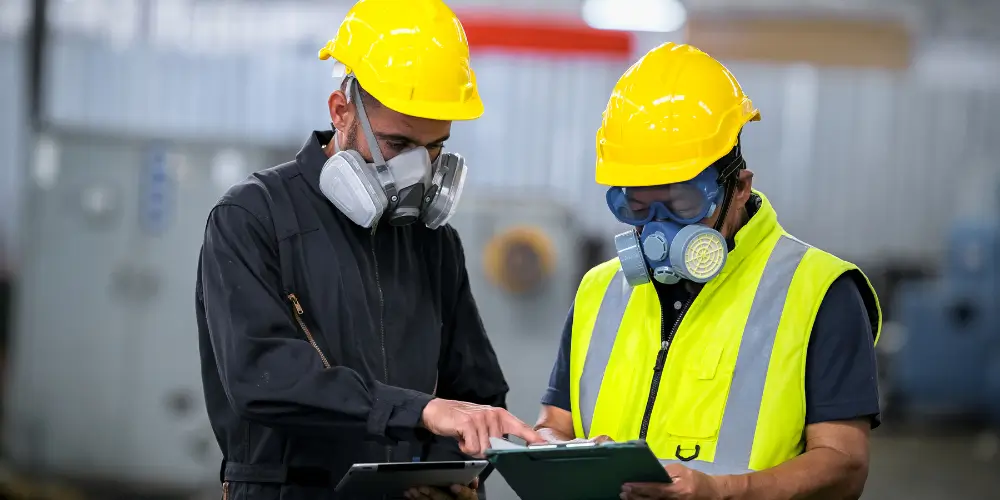Fire risk assessments in the UK are essential for property safety and legal compliance and are differentiated into four main types. Type 1 assessments offer non-destructive checks of public access areas, ideal for routine evaluations. Type 2 involves destructive methods to unravel concealed risks within complex infrastructures, requiring subsequent restoration. Type 3 assesses both private residences and communal spaces non-destructively, particularly in buildings with multiple occupants. Finally, Type 4 is the most thorough, incorporating destructive techniques to thoroughly inspect both shared and private areas, suited for properties with historical safety concerns or intricate architectures. Each method addresses different levels of risk, structural characteristics, and compliance needs, guiding stakeholders towards the most beneficial and efficient safety strategies.
Key Takeaways
- Type 1 Fire Risk Assessments focus on non-destructive checks of communal areas, which is ideal for initial safety evaluations.
- Type 2 Fire Risk Assessments involve destructive methods to uncover hidden hazards in complex buildings, requiring restoration post-assessment.
- Type 3 Fire Risk Assessments are comprehensive, non-destructive evaluations that include both communal and private areas in multi-occupancy properties.
- Type 4 Fire Risk Assessments are the most exhaustive, using destructive techniques in all areas. They are crucial for structures with historical safety concerns.
- Each assessment type is chosen based on factors like building complexity, occupancy, and previous safety outcomes to enhance targeted fire safety management.
Table of Contents
Understanding Fire Risk Assessments
Fire risk assessments are essential for ensuring the safety and compliance of London properties, identifying potential hazards and evaluating the adequacy of existing fire safety measures.
In the UK, property owners are legally obligated to adhere to the Regulatory Reform (Fire Safety) Order 2005, which mandates a systematic evaluation of fire risks and the implementation of appropriate safety precautions.
This legislation enhances the protection of occupants and delineates the responsibilities of property managers and owners in maintaining fire safety standards.

Why Fire Risk Assessments Are Essential for London Properties
In London’s densely populated urban landscape, fire risk assessments are essential for ensuring the safety and security of both residential and commercial properties. Conducting these assessments involves a meticulous evaluation of the potential fire hazards within a property, which is vital for developing robust fire safety protocols.
These protocols are important not only in minimising the risk of fire but also in ensuring swift and effective emergency response planning, ultimately safeguarding human life and property assets.
Property owners are mandated to integrate thorough fire prevention strategies based on these assessments. The benefits of risk assessments extend beyond mere compliance; they provide a foundational strategy for identifying key areas that require fire safety enhancements.
Through systematic identification and rectification of potential fire hazards, property owners can greatly mitigate risks, thereby enhancing the overall resilience of buildings against fire incidents.
Moreover, the strategic insights gained from fire risk assessments guide the development of emergency response plans. These plans are tailored to each property’s unique layout and specific fire risks, ensuring that both occupants and emergency responders are well-prepared for potential fire scenarios. Thus, the coordination and efficiency of response efforts are optimised.
Legal Requirements for Fire Safety in the UK
Under UK legislation, every commercial, industrial, and residential building must undergo a thorough fire risk assessment to comply with the Regulatory Reform (Fire Safety) Order 2005. This legal requirement guarantees a foundational level of protection against the risk of fire. It is enforced rigorously across the United Kingdom by designated enforcement agencies.
These agencies not only oversee compliance but also have the authority to impose sanctions on entities failing to meet the mandated fire safety regulations.
Compliance guidelines are detailed and require that the responsible person typically the property owner or occupier undertake periodic assessments that account for all potential fire hazards, propose measures to mitigate risk and guarantee that these measures are effectively implemented and maintained.
This process includes but is not limited to, the examination of fire detection systems, emergency exits, fire extinguisher availability, and occupant safety training.
Legal obligations also extend to maintaining a clear record of all risk management activities, including details of any identified risks, the decisions made, and actions taken to mitigate those risks.
This documentation must be readily available for enforcement agencies to review during inspections to verify adherence to fire safety standards.
Non-compliance can lead to legal repercussions, underlining the critical nature of strict adherence to fire safety protocols.
Understanding the Regulatory Reform (Fire Safety) Order 2005
The Regulatory Reform (Fire Safety) Order 2005 mandates an extensive framework for managing fire risks within commercial and residential buildings throughout the UK to guarantee ideal safety and compliance. This legislation is pivotal in establishing a systematic approach to fire safety, which is integral to the strategic planning of risk management.
It obliges the responsible person, typically the premises owner or occupier, to conduct thorough fire risk assessments regularly to identify potential hazards and implement effective safety procedures.
The Order emphasises the importance of regulatory compliance through continual monitoring and revision of safety measures in response to any changes in building use or structure, ensuring that all safety protocols remain robust and effective. This proactive approach is critical in mitigating risks and safeguarding occupants.
Furthermore, the Order has undergone several legislative updates to refine and enhance the regulatory framework, ensuring it remains relevant to evolving building techniques and materials.
These updates necessitate that fire safety professionals maintain a high level of expertise and stay informed of the latest safety standards and procedures, reinforcing the culture of safety and compliance.
Type 1 Fire Risk Assessment: Non-Destructive Evaluation of Common Areas
Type 1 Fire Risk Assessments focus primarily on the nondestructive evaluation of common areas, which encompasses a precise inspection without damaging the property.
These assessments are vital in identifying potential fire hazards and ensuring compliance with fire safety regulations. Still, their surface-level examination restricts them and may not uncover hidden threats.
The ideal implementation of Type 1 assessments occurs in buildings with high-traffic common areas where minimal intrusion is essential. Yet, a foundational level of safety needs to be confirmed.
Scope and Limitations of Type 1 Assessments
Several factors define the scope and limitations of Type 1 Fire Risk Assessments, primarily focused on the non-destructive evaluation of common areas within a building. This assessment type strategically avoids invasive measures, thereby preserving the structural integrity and aesthetic value of the property.
The primary advantage of Type 1 assessments lies in their minimal disruption to daily operations, making them suitable for occupied buildings where extensive downtime is not feasible.
However, the non-destructive nature of Type 1 assessments introduces certain limitations. Significant insights into concealed spaces, such as behind walls or above ceilings, remain unexplored, potentially overlooking hidden risks. This limitation necessitates a clear understanding of risk assessment criteria that prioritise observable elements while acknowledging the areas beyond the assessment’s reach.
Another notable factor is the cost-effectiveness of Type 1 assessments, which often makes them an attractive first step in a thorough fire safety strategy. Yet, this cost advantage must be weighed against the possible need for subsequent, more intrusive assessments should initial findings suggest deeper concerns.
Stakeholder involvement is essential in setting realistic expectations and understanding the scope of the assessment. Effective communication about the capabilities and limitations of Type 1 assessments guarantees that all parties are aligned, promoting informed decision-making and strategic planning in fire risk management.
Ideal Scenarios for Implementing Type 1 Assessments
What are the ideal conditions for employing Type 1 Fire Risk Assessments?
Certain conditions are particularly conducive to optimising the efficacy of a Type 1 Fire Risk Assessment. These non-destructive evaluations are best implemented in buildings where the assessment can be confined primarily to common areas, thereby minimising disruption to individual occupants.
Ideal assessment scenarios include residential complexes or commercial buildings with significant shared spaces such as lobbies, hallways, and amenity sites. Here, the type 1 advantages come into full play by allowing a thorough analysis of these areas that are vital to the safety of all building users without the need for invasive measures that might disturb private zones.
Moreover, assessment timing considerations are significant; for instance, scheduling assessments during periods of low activity in these common areas can enhance both the process’s efficiency and the findings’ accuracy.
Lastly, property owner responsibilities must be clearly defined and adhered to, ensuring that all necessary measures are taken post-assessment to address identified risks. This proactive stance is essential in maintaining the integrity of the fire safety strategy within the property, safeguarding both assets and occupants.

Type 2 Fire Risk Assessment: In-Depth Analysis with Destructive Inspection
Type 2 Fire Risk Assessments are essential when standard visual inspections cannot conclusively assess fire hazards, particularly in complex structures within London.
These assessments involve destructive testing methods to evaluate concealed elements like structural compartments and fire-stopping measures, which are pivotal in high-risk environments.
Understanding the intrusive nature of these assessments helps stakeholders prepare for the temporary disruption and restoration process that follows detailed examination.
When to Opt for a Type 2 Assessment in London Buildings
Evaluating the structural integrity and safety features of London buildings often necessitates a Type 2 Fire Risk Assessment, especially when previous evaluations suggest potential hidden hazards. This advanced assessment is imperative under certain conditions to guarantee compliance with fire safety regulations and to refine risk evaluation strategies.
Implementing a Type 2 Assessment is vital in scenarios where complex building types such as heritage structures or extensively modified properties present unique challenges that a basic assessment cannot address. This in-depth approach allows for a meticulous analysis of concealed elements that could compromise the building’s fire safety integrity.
A strategic understanding of assessment guidance and compliance strategies should drive the decision to opt for a Type 2 Assessment. It is essential for properties where modifications have obscured original design intents or where materials of unknown fire resistance are in use.
Table: Deciding Factors for Type 2 Fire Risk Assessment
| Factor | Detail |
| Previous Assessment Outcomes | Indications of potential hidden hazards |
| Building Complexity | Heritage or modified structures requiring deeper investigation |
| Regulatory Compliance | Necessity to meet stringent fire safety standards |
| Risk Mitigation | A proactive approach to identify and rectify hidden risks |
This table encapsulates the significant considerations that underscore the need for a Type 2 Assessment in London buildings.
Understanding the Intrusive Nature of Type 2 Assessments
Delving into the specifics of a Type 2 Fire Risk Assessment reveals its inherently intrusive nature, characterised by the necessity for destructive inspection methods. This level of evaluation goes beyond the superficial examination typical of Type 1 assessments, incorporating techniques that may involve the removal or alteration of building components to access concealed spaces.
The rationale behind such intrusive methods is grounded in a thorough risk evaluation. These methods aim to uncover potential fire hazards that are not visible during non-invasive inspections.
Implementing these methods requires a meticulous planning process to guarantee that the structural integrity and historical value of the property are not compromised. Additionally, the detailed nature of these inspections mandates a high level of expertise from the evaluating personnel, who must balance the thoroughness of the assessment with the imperative of safety compliance.
Type 2 assessments are particularly critical in buildings where the complexity of electrical systems, ventilation shafts, and other hidden installations pose significant fire risks. By employing a combination of visual checks and destructive techniques, these assessments provide a deep insight into the property’s fire safety status, thereby facilitating informed decisions aimed at enhancing building safety and compliance.

Type 3 Fire Risk Assessment: Comprehensive Evaluation Including Individual Flats
Type 3 Fire Risk Assessment facilitates a detailed evaluation that encompasses both private flats and communal areas within multi-occupancy buildings, employing non-destructive inspection techniques.
This assessment type is particularly advantageous for large residential complexes as it provides a thorough safety analysis without damaging the property.
Opting for a Type 3 assessment guarantees that all potential fire risks are identified and addressed, enhancing the overall safety of the building’s occupants.
Non-Destructive Inspection Covering Private and Common Areas
Within the scope of Type 3 Fire Risk Assessments, non-destructive inspections play a crucial role in safeguarding residential buildings’ private and common areas.
These inspections utilise non-destructive techniques, which are essential for evaluating the integrity and safety compliance of structures without causing any damage or disruption to the property. This approach enhances inspection efficiency, allowing property management to continue operations unimpeded while simultaneously adhering to stringent safety regulations.
The methodology behind non-destructive inspections in fire risk assessments involves a meticulous examination of electrical systems, escape routes, fire doors, and other key infrastructure.
The focus is on identifying potential risks and implementing risk mitigation strategies that conform to current safety standards. This type of assessment is instrumental in creating a thorough safety profile for each unit and shared space, guaranteeing that all aspects of fire safety are addressed.
Property management teams must leverage these insights to institute preventative measures and maintain continuous compliance with fire safety regulations.
Benefits of Choosing a Type 3 Assessment for Multi-Occupancy Buildings
Choosing a Type 3 Fire Risk Assessment for multi-occupancy buildings presents numerous advantages, particularly due to its thorough approach, which includes evaluating individual flats as well as communal areas. This method considerably enhances safety compliance by guaranteeing that every aspect of the building adheres to current fire safety regulations, which is vital for the protection of all residents.
Type 3 assessments excel in risk mitigation by identifying potential fire hazards in both shared spaces and within separate dwellings. This dual focus allows for an all-encompassing analysis of fire risks that might otherwise be overlooked in less detailed assessments.
For property managers and owners, this level of scrutiny translates into Multi-occupancy benefits by providing a safer environment for tenants, potentially reducing insurance premiums and increasing property value through demonstrated diligence in safety practices.
Moreover, the Assessment efficiency inherent in the Type 3 approach streamlines the evaluation process. Concurrently evaluating multiple units reduces the overall time and resources spent on separate assessments, thereby optimising operational efficiency.
This integrated assessment model guarantees a high standard of fire safety and promotes a systematic approach to building management, making it invaluable in the sphere of property safety and compliance management.
Type 4 Fire Risk Assessment: The Most Extensive and Intrusive Evaluation
Type 4 Fire Risk Assessment represents the pinnacle of thoroughness in evaluating fire safety. It encompasses destructive inspection techniques and a focus on all accessible areas within a building.
This level of assessment is typically mandated in scenarios where the complexity of building structures or historical safety issues necessitate a more aggressive and detailed examination.
It involves scrutinising both common spaces and private domains to identify hidden risks and guarantee compliance with the most stringent fire safety regulations.
Combining Destructive Inspection of Both Common and Private Areas
In the domain of fire safety, a Type 4 Fire Risk Assessment represents the most thorough method of investigation. It entailed both destructive inspection and careful evaluation of common and private areas within a building.
This extensive approach is essential for exhaustive risk management and safety evaluation, aiming to uncover hidden hazards that might not be detected through less invasive methods.
The process involves several critical activities:
- Structural Analysis: Inspecting structural elements like beams, columns, and fire stops within walls to assess their integrity and fire resistance capabilities.
- Material Assessment: Evaluating the flammability of building materials used in both common and private areas, including insulation, panelling, and flooring.
- Service Installations Check: Examining electrical wiring, gas lines, and HVAC systems to identify any potential fire risks due to faulty installations or deteriorations that are typically concealed behind surfaces.
Situations Need a Type 4 Fire Risk Assessment
Why might a Type 4 Fire Risk Assessment be necessary? This level of assessment is typically required in complex building structures or where previous assessments indicate severe risk potentials that cannot be accurately gauged through less invasive methods.
A Type 4 assessment involves detailed destructive inspection techniques to fully evaluate hidden areas that could harbour significant fire risks.
Key criteria for initiating a Type 4 assessment include a history of structural modifications, the presence of aged or inaccessible fire stops, and environments with high-risk operations or materials.
The assessment team must possess advanced qualifications, including expertise in structural engineering, fire protection systems, and forensic analysis, to guarantee a thorough and accurate risk evaluation.
The cost implications of a Type 4 Fire Risk Assessment are considerably higher due to the extensive nature of the inspections and the specialised expertise required.
However, these costs are justified by the vital insights gained, potentially averting catastrophic fire events and subsequent financial and human losses.
Frequency recommendations for Type 4 assessments depend on the building’s risk profile and operational changes.
Regular updates to the risk assessment documentation are essential. They guarantee compliance with evolving safety standards and the integration of new risk mitigation technologies.

How to Determine the Appropriate Fire Risk Assessment for Your Property
Determining the appropriate fire risk assessment for a property in London involves a meticulous evaluation of several critical factors.
These factors include the building’s age, design, usage, and the potential hazards associated with its environment.
A strategic approach to selecting the right assessment type guarantees compliance with regulatory standards and enhances safety and risk management.
Factors to Consider When Selecting an Assessment Type
Selecting the appropriate fire risk assessment type for a property requires careful consideration of several key factors. The intricacy of these decisions is underscored by the diversity in property types, each presenting unique challenges and risk profiles. To guarantee that the selected assessment type aligns well with specific needs, several vital elements must be thoroughly analysed.
Property Type and Building Age
Older structures might possess outdated materials prone to fire hazards, necessitating a more detailed and historical approach. Conversely, modern buildings could benefit from assessments that focus on current architectural norms and materials used.
Occupancy
Levels
Buildings with high foot traffic, such as commercial complexes or residential blocks, demand assessments that account for the increased human activity and potential sources of fire ignition. This factor is essential in determining the frequency and depth of inspections.
Risk Factors Specific to the Locale
properties are often influenced by their urban setting, where proximity to other buildings and the history of local fire incidents play significant roles. Tailoring the assessment to incorporate these local risks guarantees a more accurate and effective evaluation.
Through analytical scrutiny of these assessment criteria, stakeholders can make informed decisions that enhance fire safety and compliance.
Benefits of Regular Fire Risk Assessments for London Businesses and Residents
Regular fire risk assessments offer considerable benefits to both businesses and residents in London. They enhance safety protocols and ensure a higher degree of peace of mind.
These assessments critically identify and mitigate potential fire hazards, which is particularly essential in dense urban environments where the risk of fire spread is markedly increased.
Enhancing Safety and Peace of Mind
Conducting systematic fire risk assessments offers London businesses and residents significant benefits by enhancing safety and instilling a greater sense of peace of mind.
Regular evaluations bolster fire prevention strategies and refine emergency planning, guaranteeing a structured response in the event of a fire. This proactive approach assists in maintaining property compliance with evolving safety regulations, thereby supporting risk management processes.
Key benefits include:
- Enhanced Safety Protocols: Regular assessments contribute to the development and reinforcement of robust safety protocols, minimising the risk of fire incidents through strategic prevention measures.
- Optimised Risk Management: Effective fire risk assessments thoroughly analyse potential vulnerabilities within a property or business operation. This enables the implementation of precise risk management strategies tailored to specific environmental and operational conditions.
- Compliance with Regulations: Staying abreast of current fire safety regulations is vital for legal compliance. Systematic assessments guarantee that all aspects of a property adhere to the latest safety standards, protecting against legal repercussions and potential fines.
Through these assessments, businesses and residents can achieve an advanced understanding of fire-related risks, leading to improved safety outcomes and peace of mind.

Reducing Potential Fire Hazards in Urban Settings
In urban settings, the dense concentration of buildings and high population density amplify the importance of conducting regular fire risk assessments to mitigate potential hazards effectively. Such assessments are essential in identifying vulnerabilities within urban infrastructures, where the risk of fire can have catastrophic consequences due to the proximity of structures and their varied uses.
Regular fire risk assessments contribute considerably to urban fire prevention by enabling businesses and residents to understand and manage the risks associated with their environments. This proactive approach supports the development of effective emergency response planning, which is vital in densely populated areas.
Additionally, these assessments enforce adherence to building material regulations, ensuring that all constructions within the urban landscape are up to code and incorporate fire-resistant materials, thereby reducing the potential for rapid fire spread.
Community safety initiatives often leverage findings from fire risk assessments to craft targeted public awareness campaigns. These campaigns educate the public on fire safety practices and encourage active participation in maintaining fire safety standards.
Through a combination of regulatory compliance and informed community action, regular fire risk assessments serve as a foundational element of a thorough strategy to enhance safety and resilience in urban settings.
What happens if I fail to conduct a fire risk assessment?
Failing to conduct a fire risk assessment can result in significant legal repercussions under UK law, particularly for businesses and property owners.
Non-compliance can attract penalties that range from substantial fines to, in severe cases, imprisonment.
These punitive measures are enforced to guarantee adherence to safety regulations and to mitigate potential fire hazards effectively.
Penalties for Non-Compliance in UK
Non-compliance with fire risk assessment regulations in the UK frequently results in severe penalties, underscoring the critical nature of these safety measures. For those responsible for building management, understanding the penalties overview, compliance consequences, enforcement measures, legal implications, and financial repercussions of failing to conduct a proper assessment is vital.
- Legal Implications: Failure to comply can lead to prosecution under the Regulatory Reform (Fire Safety) Order 2005. Convictions may result in criminal records, which can negatively impact the responsible individual’s or entity’s reputation and their ability to conduct business.
- Financial Repercussions: Fines for non-compliance can be substantial. Depending on the severity of the oversight and the perceived risk to life, fines can reach unlimited amounts, posing significant financial strain on the entity. In severe cases, the cost of legal proceedings can further exacerbate the financial burden.
- Enforcement Measures: Enforcement actions can include formal notices requiring rectification of non-compliance issues. Failure to address these notices can lead to the closure of premises, which disrupts business operations and leads to loss of income.
Entities must prioritise fire risk assessments to avoid these severe consequences. Regular reviews and updates of fire safety measures, guided by professional assessments, are essential to guarantee compliance and safety.
Outsourcing vs. In-House Assessments
Choosing the appropriate fire risk assessment method for a property involves evaluating the capabilities and resources available in-house versus the expertise offered by external providers.
Outsourcing may provide access to specialised knowledge and technology that can more accurately identify potential risks and compliance issues, particularly for complex or large-scale facilities.
Conversely, conducting assessments in-house might offer greater control over the process and potentially lower costs. Still, it requires sufficient expertise and ongoing staff training to guarantee thoroughness and compliance with current regulatory standards.
How do I choose the right type of fire risk assessment for my property?
Deciding between outsourcing and conducting an in-house fire risk assessment requires a careful analysis of both methodologies to guarantee ideal safety and compliance with regulatory standards. The choice hinges on several factors, primarily the nature and complexity of the property in question, the expertise available internally, and the specific fire safety principles that need to be addressed.
In-depth consideration of the following points can guide the decision-making process:
Expertise and
Resources
Evaluate whether your internal team has the necessary skills and resources to implement thorough risk management and emergency planning. Outsourced professionals often bring specialised knowledge, particularly.
Assessment Frequency and Scope
Depending on the property’s size and use, the required frequency and scope of assessments may dictate the need for a dedicated external team that can regularly update and maintain fire risk protocols.
Cost versus
Benefit
Analyze the cost implications of both options. While outsourcing can be initially more expensive, the investment may prove economically viable in the long run with reduced liability and enhanced safety outcomes.
Ultimately, the decision should align with your organisation’s capacity to effectively manage fire risks and ascertain compliance with evolving fire safety regulations.
Frequently Asked Questions
How Often Should Fire Risk Assessments Be Updated?
Fire risk assessments should be updated according to frequency guidelines, adhering to assessment intervals defined by organisational policies, ensuring robust risk management, and maintaining regulatory compliance. Continuous monitoring and evaluation are essential for ideal safety outcomes.
Are Online Fire Risk Assessments Legitimate?
Maneuvering the digital landscape, online fire risk assessments must align with rigorous certification requirements to guarantee validity. These assessments, leveraging digital tools for remote evaluations, need thorough verification to be considered legitimate and effective.
What Training Is Required to Perform Fire Risk Assessments?
To conduct fire risk assessments, individuals must undergo thorough fire safety training, obtain specific risk assessment qualifications, participate in certification programs, and gain practical assessment experience, ensuring compliance with prevailing industry standards.
Can Technology Improve the Accuracy of Fire Risk Assessments?
Yes, technology can enhance fire risk assessment accuracy through AI advancements, predictive analytics, IoT integration, automated reporting, and data visualisation, offering detailed, real-time insights to mitigate potential fire hazards effectively.
What Are the Legal Consequences of Not Following Assessment Recommendations?
Non-compliance with assessment recommendations can lead to legal penalties, heightened liability issues, adverse insurance ramifications, and significant compliance failures, ultimately culminating in safety violations that jeopardise both human lives and property integrity.

